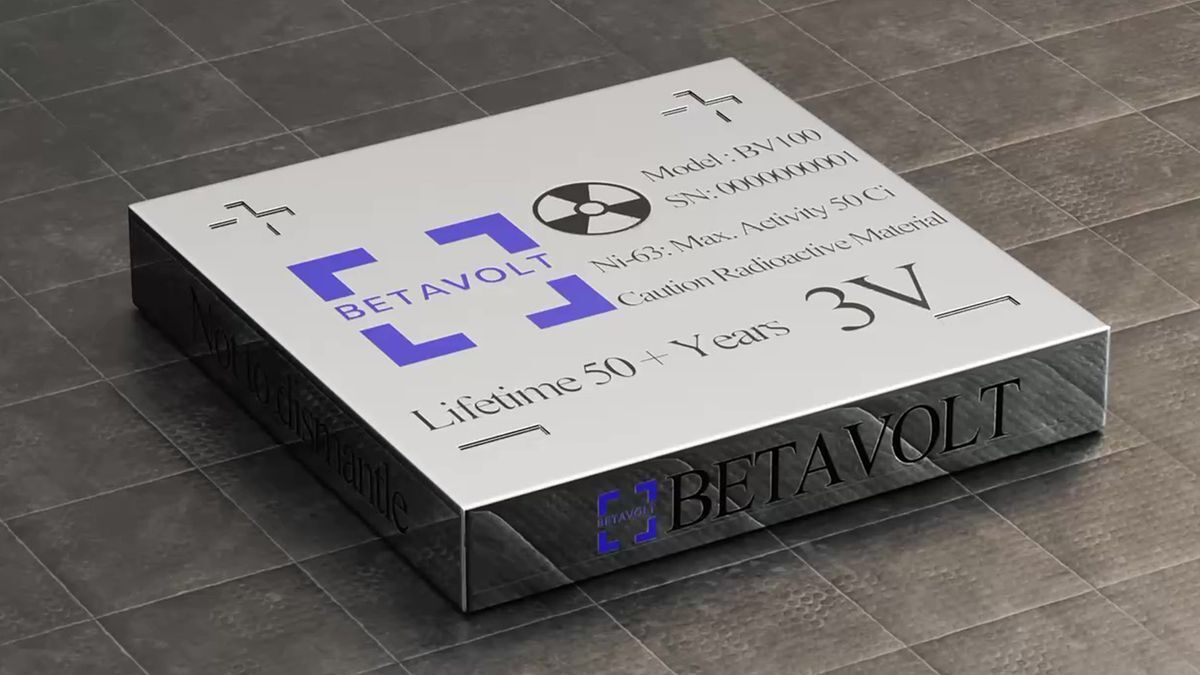- cross-posted to:
- [email protected]
- cross-posted to:
- [email protected]
A tiny radioactive battery could keep your future phone running for 50 years::A glowing horizon for phones
And now for 50 years worth of security updates for a phone like that. Not to mention what people might do with throwing a phone in the trash or something
I’d take it if it was a reasonable price, like 1k, and if I could just swap it into new phones every time I upgraded.
The problem is, power requirements tend to increase as computation power increases. And no doubt battery tech will improve in those 50 years.
They already sell phones over 1k that are expected to last ~4 years. You’ll need to tag another zero or two to that price to incentivize manufacturers.
They could do it to gain market share.
So what if power requirements increase. It could quadruple and now my battery will only last twelve years? There are plenty of other things that will start failing before then.
I don’t know about this particular tech, but you can’t really control the speed of radioactive decay very easily. It’s possible they’re doing something, but if they’re just collecting the energy then there’s nothing you can do to get more energy in exchange for a shorter life
That’s fair.
Isn’t decay exponential though? So there would likely be some extra power being wasted at the beginning? Until it couldn’t supply however much is needed today? Or is that timeline long enough that 50 years is basically nothing?
It depends on the half life of the element in question. The most comparable concrete thing we can compare this to with real numbers because we know it works is an RTG. RTGs are solid-state generators, but people could colloquially refer to them as “batteries” and not be terribly wrong. They take a quantity of a radioactive material and allow it to decay, using the heat given off to establish a thermal gradient which is then converted to electricity via thermocouples. Most of these are “fueled” with Pu-238 (at least the ones for spacecraft), which has a half life of 87.7 years. That means in 87.7 years, if you started with 4kg of Pu when you built it, you’d have only 2kg of Plutonium left. If the Pu decayed only into stable isotopes (it doesn’t) then your radioactive emissions/decay would also be exactly halved at this time. If the electrical system is perfectly efficient this would also halve the electrical power produced.
I provide this all as background because to answer your question you have to know three key factors about the device to determine the lifetime of the battery. The half-life of the isotope used, the minimum electrical requirements of the device you’re powering, and the amount of radioactive material in the initial battery. The battery’s lifetime is determined by when decay will decrease the ongoing energy output below the minimum current and voltage requirements needed by the battery. The longer the half life of the isotope, the slower this decrease is and the less initial overpowering that is required.
Ex. If you use an isotope with a 12.5 year half life for a “50-year” battery, you would need to start with 8 times the material needed for your minimum power output requirements. If you use an isotope with a 200 year half life, you only need 19% more starting mass than you minimum requirement. The first battery will produce 8x the power at the very beginning, while the second will only produce 18% more.
The EU are going to mandate removable batteries in phones, so I don’t see any reason you can’t take a standardised battery that lasts decades and swap it into your next phone, if they’re all designed properly with compatibility with this miracle battery in mind :-D
Perfect. Then they’ll sell the battery separately and it’ll cost $5000
A battery that last several years and can be used in a plethora of devices would be reasonably expensive yes. $5000 is a lot but maybe $500 is more reasonable for something like that?
Exactly; if Usually, it takes years, if not decades, before laws and regulations are actually in place
I’m not so optimistic.
When ever we discover a new, much better power source, the cartel who is going to lose a shitton of business go on a smear campaign. Look at solar power. Look at electric cars. Hell, look at hemp.
Companies would bury this so fast, and this tech would be a niche thing.
The isotope degrades into copper.
No. Document the device for PC-like lifetime software support from first and third party. Long security update support for phones, great, but we still have a stupid thing when people buy whole new phone for little software feature.
At this moment, 1 gram of radioactive Nickel-63 costs around 4,000 USD. Nickel-63 isotope does not occur in nature, it is obtained by irradiating Nickel-62 inside a nuclear reactor.
The world needs breeder reactors anyways, build out a lot of gen 4 plants and make Nickle-63 to boot.
What happens when the casing get punctured? When you mass produce these devices these things will happen.
Probably the same as with tritium lumes. Only dangerous if you swallow the unshielded nickel.
So literal death sentence, got it.
I mean so is drinking a gallon of bleach. Fortunately, there’s a pretty simple preventative measure for both:
Don’t do it?
What gave you the idea that swallowing a small amount of mildly radioactive material is fatal?
Man, I figured the joke was obvious but I guess not.
“tiny amount of radioactive material whose radiation stopped by thin plastics is a literal death sentence” is, I thought, pretty clear hyperbole.
A lot of people are really irrationally afraid of anything involving radiation. I mistook you for one of them.
No worries. Glow it up, let’s get some extreme energy density up in this bitch. I went for nuke in the old days where I enlisted in the military.
I have a healthy respect for radiation. That’s why I leave handling the good stuff to the professionals.
I’ve actually got some small isotope samples in a lockbox from an old highschool demonstration lab for Geiger counters. No Geiger counter though yet. I haven’t even opened it since I got it to check the contents were intact.
deleted by creator
Surely the battery itself would have sufficient protection on top of the devices chassis offering protection.
I can’t say a Lithium Ion battery leaking in the body would bode very either.
Standford?
It’s a a rival of Hardvard.
Most prestigious school in all of milwalkee
Like a phone would last 50 years.
A tiny radioactive battery could keep a piece of e-waste using power for 48 years
Generating power…
… that go on to mutate rats who grow old and train mutant turtles in the ninja arts.
With the EU requireing replaceable batteries, I could imagine buying a battery and changing the phone for it.
I could go for that.
How long can it power a disposable vape? Lol jk
Don’t give them any ideas…
Sounds like alot of infertility and ass cancer in the future… lets see how this plays out
Nuclear power at small scale is already in use in devices. Some medical devices, smoke detectors etc. As long as there is proper shielding, the enclosure is robust enough, and the overall device is made easily serviceable, I’m all for it. I can understand the fear sentiment of anything flagged as radioactive, but radiation is all around us already. Idk, but the less we can ditch super toxic and explosive lithium the better.
The radioactive source isn’t used for power in smoke detectors, it’s used to detect smoke. What small scale devices use radioactivity actually for power?
My grampa had a pacemaker that was.
Edit: Source - https://osrp.lanl.gov/pacemakers.shtml
Edit2: For the smoke detectors, i know its not what powers it per se, as far as the electronics that sound the alarm and such. More pointing out it contains radioactive material, and is something in every (hopefully) house, and you likely walk by it often.
That is well cool
.
Here’s the real issue with the bs fluff title and complete fabrication of what these can be used for. It says in the article the battery makes 100 microwatts at 3v. Well that’s an insanely small wattage. Your phone requires like 2 to 10 watts when youre on it. Regular watts.
One single watt is 1,000,000 microwatts. It would take 10,000 of these radioactive 50 year batteries ran together in parallel for just a watt of power. You’d need like 100,000 of them in your phone to cover all power requirements.
So, you’re saying there’s a chance :p
The sentiment for me here, is any overall betterment of portable power is good. Yea the article and this specific tech is presented in an overhyped fashion, no doubt.
The issue is not the radioactivity, it’s the power density. Per the article, this is ~24x smaller than an average phone battery, but can supply only 100uW.
I have a relatively conservative phone use, and on average, my phone uses 450mW. That means that you’d need 4500 of those batteries in your phone. But the battery would also need to cover the power usage peaks, which are multiple times higher than the average power consumption.
Ya know we keep these things in our pants right?
No offense but it’s a “I wasn’t paying attention in high school physics” comment. It being beta decay with a half-life of 100 years should already indicate it’s relatively safe. In fact someone else in this thread already already added the references showing how safe it is. If it’s safe enough to power a pacemaker it’s safe enough to sit in your phone that sits your pocket.
Personally I think that battery would have much bigger issues than safety, such as power requirements which are much harder to control with nuclear decay. Also obviously the device itself deprecating before the battery because tech will definitely advance a lot in 50 years, I imagine after a decade the phone will be useless. And finally the pricing considering Ni-63 doesn’t occur in nature which means you need a specific process to create the materials necessary for the batter.
I imagine after a decade the phone will be useless.

I’ll concede, useless was a bit harsh. Let’s say “no longer fit for the average user” considering the average lifespan of a mobile phone is 2-4 years and a company doing software and security updates for a decade is very rare.
You are very much the exception here.
That’s a silly comparison. You’re not dropping your pacemaker down escalators or throwing it the trash when the screen breaks, and middle schoolers aren’t dissambling them with butter knives. You’re not throwing them out every few years. Please teach me more about high school physics though you smug sob.
Most current phones use lithium ion batteries that can combust or explode in your pocket if tampered or damaged, but you don’t seem to be worried about that. You only seem to be worried about the battery in the article because the only thing you remember about radiation from your high school physics is “radiation bad”. Had you paid more attention in school you wouldn’t need my smug ass correcting you.
You are just moving goalposts here. None of these scenarios are particularly relevant anyway. Even if the phone shell cracked, the battery casing would be enough to shield from the radiation. And what does throwing the phone in the trash have to do with keeping it in your pocket.
You’re just not trying hard enough.
Finally, Asimov got it right
He got it right in a lot of aspects, partially because he didnt gave many details about certain stuff, but I remember a pretty good description of a nuclear powered e reader… if I remember it correctly, the nuclear part was a tiny nuclear reactor though
Seemed like all the writing of that era was under the spell of nuclear power. I remember thinking “wtf?” to a nuclear-powered desk side trash incinerator in one of Asimov’s books. Maybe Foundation.
Some of the people here don’t realize that our smoke detectors have radioactive elements inside it
Some people havent read the article where it states they use radioactive batteries like this in pacemakers and that there is no external radiation from the battery.
Depends, in my country ionization detectors have been banned over 20 years ago, you’ll mostly find optical / photoelectric detectors here.
I wonder if its because of a valid reason, or just a precaution
It’s probably safe until someone decides to go look what’s inside their smoke detector
I don’t put smoke detector next to my head for every night.
Or right next to my balls for like 10 hours a day.
Remember when folks wore watches with radioactive paint on them? Good times.
It would’ve been great if they used reasonable safety precautions in making them.
Yeah, unfortunately most of the danger fell on the (usually female) factory workers who painted the radium on. Fun fact, we do absolutely still use radioactive shit to make watches glow today, it’s just much less dangerous and sealed in tiny vials. Also it’s a gas that won’t eventually flake and turn into super fine particulate, like the radium paints of yore.
It was more a problem of licking the little brushes than wearing the teeny bit on the wrist.
Battery scam #364256373
I’m seeing at least 5 of these per week now, can we PLEASE stop this bullshit?
Also, batteries from radioactive elements is one of the stupider ideas that has been floated around, sounds about at the same level as the thorium powered car.
It would be so nice if tech sites could write about actual tech and not CGI bullshit dreamed up by a guy who really isn’t going to scam you, he just needs a little bit of start up capital for his Ferrari.
I’ve heard of these kinds of batteries before and it’d be cool to have long-running electronics, but would these produce enough power?
They do, if you give them enough room. And if you are born into an oil family.
The power density is about 0.01125m³ per watt. A high end smartphone (11w of peak power) with a body size similar to Galaxy s23 ultra, would be almost 10 meters thick.
To be fair, it only needs to cover the phone’s average power draw if you put in a supercapacitor or small conventional battery.
But there’s another problem… if I understand how this works correctly, for a 1W battery, the radioactive element must be outputting AT LEAST 1W of radiation energy at all times, whether it’s being consumed as electricity or not. Ideally that’s all trapped inside as heat in a best case scenario, but having to cool your battery while it’s not in use is kind of a deal breaker for anything more than milliwatts (or it will have to have a heatsink as big as the battery)
The batteries are already connected to a “heatsink” in the phones we use now. Fast charging can be as lossy as 86% for lithium ion batteries qt very high charge rates, so the 60w fast charging will dissipate more than 6w of heat already.
And yes, the radiation battery either has to constantly use the power or it will be just pumping the voltage up until something starts to conduct
Not last I saw. They produce way too little power at that scale.
Flight safe, or nah?
What if it gets caught or crushed in the seat or luggage?
Yeah. Sure.
What could possibly go wrong…?
(FWIW - I am referring to the potential for misuse at scale)
AskSamsunga about phones in checked bags… And now the whole airplane is getting cancer.
Is that their new virtual assistant, AskSamsunga?

















